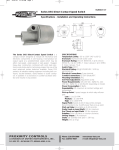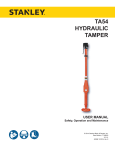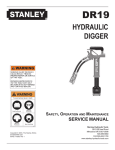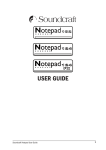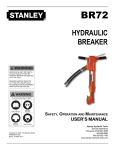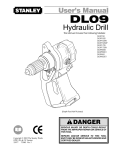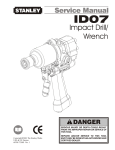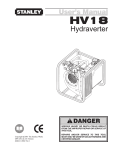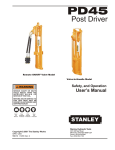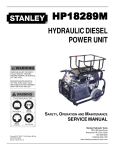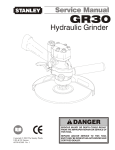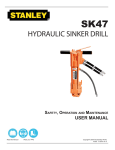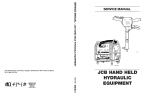Download TA54 Service
Transcript
TA54 HYDRAULIC TAMPER WARNING To avoid serious injury or death Read the Manual Wear Eye Protection SAFETY, OPERATION AND MAINTENANCE SERVICE MANUAL Wear Ear Protection Wear Dust Mask 47351 Copyright © 2003, The Stanley Works OPS/SVCE USA 16826 12/2003 Ver 2 Stanley Hydraulic Tools 3810 SE Naef Road Milwaukie OR 97267-5698 503-659-5660 FAX 503-652-1780 www.stanley-hydraulic-tools.com TABLE OF CONTENTS Safety Symbols and Precautions ..................................................................... 4, 5 Tool Stickers and Tags ........................................................................................ 6 Hydraulic Hose Requirements ........................................................................... 7 HTMA Requirements ........................................................................................... 8 Operation ............................................................................................................. 9 Equipment Protection and Care ........................................................................ 10 Troubleshooting ................................................................................................. 11 Specifications .................................................................................................... 13 Accessories ....................................................................................................... 13 Service Tools ..................................................................................................... 13 Service ............................................................................................................... 14 Parts Illustration ................................................................................................. 18 Parts List ............................................................................................................ 19 Warranty ............................................................................................................. 20 SERVICING THE STANLEY TAMPER: This manual contains safety, operation, and routine maintenance instructions. Stanley Hydraulic Tools recommends that servicing of hydraulic tools, other than routine maintenance, must be performed by an authorized and certified dealer. Please read the following warning. WARNING SERIOUS INJURY OR DEATH COULD RESULT FROM THE IMPROPER REPAIR OR SERVICE OF THIS TOOL. REPAIRS AND / OR SERVICE TO THIS TOOL MUST ONLY BE DONE BY AN AUTHORIZED AND CERTIFIED DEALER. For the nearest authorized and certified dealer, call Stanley Hydraulic Tools at one of the numbers listed on the back of this manual and ask for a Customer Service Representative. 3 SAFETY SYMBOLS Safety symbols and signal words, as shown below, are used to emphasize all operator, maintenance and repair actions which, if not strictly followed, could result in a life-threatening situation, bodily injury or damage to equipment. This is the safety alert symbol. It is used to alert you to potential personal injury hazards. Obey all safety messages that follow this symbol to avoid possible injury or death. DANGER This safety alert and signal word indicate an imminently hazardous situation which, if not avoided, will result in death or serious injury. WARNING This safety alert and signal word indicate a potentially hazardous situation which, if not avoided, could result in death or serious injury. CAUTION This safety alert and signal word indicate a potentially hazardous situation which, if not avoided, may result in minor or moderate injury. This signal word indicates a potentially hazardous situation which, if not avoided, may result in property damage. NOTICE This signal word indicates a situation which, if not avoided, will result in damage to the equipment. IMPORTANT This signal word indicates a situation which, if not avoided, may result in damage to the equipment. Always observe safety symbols. They are included for your safety and for the protection of the tool. LOCAL SAFETY REGULATIONS Enter any local safety regulations here. Keep these instructions in an area accessible to the operator and maintenance personnel. 4 SAFETY PRECAUTIONS Tool operators and maintenance personnel must always comply with the safety precautions given in this manual and on the stickers and tags attached to the tool and hose. To avoid serious injury or death These safety precautions are given for your safety. Review them carefully before operating the tool and before performing general maintenance or repairs. Read the Manual Wear Ear Protection Supervising personnel should develop additional precautions relating to the specific work area and local safety regulations. If so, place the added precautions in the space provided on page 4. Wear Eye Protection The TA54 Hydraulic Tamper will provide safe and dependable service if operated in accordance with the instructions given in this manual. Read and understand this manual and any stickers and tags attached to the tool and hoses before operation. Failure to do so could result in personal injury or equipment damage. Wear Dust Mask 47351 • Operator must start in a work area without bystanders. The operator must be familiar with all prohibited work areas such as excessive slopes and dangerous terrain conditions. • Establish a training program for all operators to ensure safe operation. • Do not operate the tool unless thoroughly trained or under the supervision of an instructor. • Always wear safety equipment such as goggles, ear, head protection, and safety shoes at all times when operating the tool. Never wear loose clothing that can get entangled in the working parts of the tool. • Do not inspect or clean the tool while the hydraulic power source is connected. Accidental engagement of the tool can cause serious injury. • Supply hoses must have a minimum working pressure rating of 2500 psi/175 bar. • Be sure all hose connections are tight. • The hydraulic circuit control valve must be in the "OFF" position when coupling or uncoupling the tool. Wipe all couplers clean before connecting. Use only lint-free cloths. Failure to do so may result in damage to the quick couplers and cause overheating of the hydraulic system. • Do not operate the tool at oil temperatures above 140°F/60°C. Operation at higher oil temperatures can cause operator discomfort and may damage the tool. • Do not operate a damaged, improperly adjusted, or incompletely assembled tool. • Know the location of buried or covered services before starting your work. • To avoid personal injury or equipment damage, all tool repair, maintenance and service must only be performed by authorized and properly trained personnel. • Do not exceed the rated limits of the tool or use the tool for applications beyond its design capacity. • Always keep critical tool markings, such as lables and warning stickers legible. • Always replace parts with replacement parts recommended by Stanley Hydraulic Tools. • Without the use of of non-conductive accessories, this tool is not for use near energized lines. Failure to comply with this warning could result in serious personal injury. • Do not overreach. Maintain proper footing and balanace at all times. • Use care when handling the tamper. Do not carry the tool by the hoses. 5 TOOL STICKERS & TAGS 05152 03783 GPM Decal Stanley Hydraulic Tools 3810 SE Naef Road Milwaukie, OR 97267 USA Model No. TA54 14908 05152 Stanley Logo Decal 3-9 GPM / 11-34 LPM DO NOT EXCEED 2000 PSI / 140 BAR DO NOT EXCEED SPECIFIED FLOW OR PRESSURE USE CLOSED-CENTER TOOL ON CLOSED-CENTER SYSTEM. USE OPEN-CENTER TOOL ON OPEN-CENTER SYSTEM. CORRECTLY CONNECT HOSES TO TOOL “IN” AND “OUT” PORTS. IMPROPER HANDLING, USE OR OTHER MAINTENANCE OF TOOL COULD RESULT IN A LEAK, BURST OR OTHER TOOL FAILURE. CONTACT AT A LEAK OR BURST CAN CAUSE OIL INJECTION INTO THE BODY. FAILURE TO OBSERVE THESE PRECAUTIONS CAN RESULT IN SERIOUS PERSONAL INJURY. 14908 Name Tag 03783 D A N G E R 1. FAILURE TO USE HYDRAULIC HOSE LABELED AND CERTIFIED AS NON-CONDUCTIVE WHEN USING HYDRAULIC TOOLS ON OR NEAR ELECTRICAL LINES MAY RESULT IN DEATH OR SERIOUS INJURY. BEFORE USING HOSE LABELED AND CERTIFIED AS NON-CONDUCTIVE ON OR NEAR ELECTRIC LINES BE SURE THE HOSE IS MAINTAINED AS NON-CONDUCTIVE. THE HOSE SHOULD BE REGULARLY TESTED FOR ELECTRIC CURRENT LEAKAGE IN ACCORDANCE WITH YOUR SAFETY DEPARTMENT INSTRUCTIONS. 2. A HYDRAULIC LEAK OR BURST MAY CAUSE OIL INJECTION INTO THE BODY OR CAUSE OTHER SEVERE PERSONAL INJURY. A DO NOT EXCEED SPECIFIED FLOW AND PRESSURE FOR THIS TOOL. EXCESS FLOW OR PRESSURE MAY CAUSE A LEAK OR BURST. B DO NOT EXCEED RATED WORKING PRESSURE OF HYDRAU LIC HOSE USED WITH THIS TOOL. EXCESS PRESSURE MAY CAUSE A LEAK OR BURST. C CHECK TOOL HOSE COUPLERS AND CONNECTORS DAILY FOR LEAKS. DO NOT FEEL FOR LEAKS WITH YOUR HANDS. CONTACT WITH A LEAK MAY RESULT IN SEVERE PERSONAL INJURY. The safety tag (p/n 15875) at right is attached to the tool when shipped from the factory. Read and understand the safety instructions listed on this tag before removal. We suggest you retain this tag and attach it to the tool when not in use. D A N G E R D DO NOT LIFT OR CARRY TOOL BY THE HOSES. DO NOT ABUSE HOSE. DO NOT USE KINKED, TORN OR DAMAGED HOSE. 3. MAKE SURE HYDRAULIC HOSES ARE PROPERLY CONNECTED TO THE TOOL BEFORE PRESSURING SYSTEM. SYSTEM PRESSURE HOSE MUST ALWAYS BE CONNECTED TO TOOL "IN" PORT. SYSTEM RETURN HOSE MUST ALWAYS BE CONNECTED TO TOOL "OUT" PORT. REVERSING CONNECTIONS MAY CAUSE REVERSE TOOL OPERATION WHICH CAN RESULT IN SEVERE PERSONAL INJURY. 4. DO NOT CONNECT OPEN-CENTER TOOLS TO CLOSED-CENTER HYDRAULIC SYSTEMS. THIS MAY RESULT IN LOSS OF OTHER HYDRAULIC FUNCTIONS POWERED BY THE SAME SYSTEM AND/ OR SEVERE PERSONAL INJURY. 5. BYSTANDERS MAY BE INJURED IN YOUR WORK AREA. KEEP BYSTANDERS CLEAR OF YOUR WORK AREA. 6. WEAR HEARING, EYE, FOOT, HAND AND HEAD PROTECTION. 7. TO AVOID PERSONAL INJURY OR EQUIPMENT DAMAGE, ALL TOOL REPAIR MAINTENANCE AND SERVICE MUST ONLY BE PERFORMED BY AUTHORIZED AND PROPERLY TRAINED PERSONNEL. I M P O R TA N T I M P O R TA N T READ OPERATION MANUAL AND SAFETY INSTRUCTIONS FOR THIS TOOL BEFORE USING IT. READ OPERATION MANUAL AND SAFETY INSTRUCTIONS FOR THIS TOOL BEFORE USING IT. USE ONLY PARTS AND REPAIR PROCEDURES APPROVED BY STANLEY AND DESCRIBED IN THE OPERATION MANUAL. USE ONLY PARTS AND REPAIR PROCEDURES APPROVED BY STANLEY AND DESCRIBED IN THE OPERATION MANUAL. TAG TO BE REMOVED ONLY BY TOOL OPERATOR. TAG TO BE REMOVED ONLY BY TOOL OPERATOR. SEE OTHER SIDE SEE OTHER SIDE SAFETY TAG P/N 15875 (shown smaller then actual size) 6 HYDRAULIC HOSE REQUIREMENTS HOSE TYPES Hydraulic hose types authorized for use with Stanley Hydraulic Tools are as follows: ! Certified non-conductive " Wire-braided (conductive) $ Fabric-braided (not certified or labeled non-conductive) Hose ! listed above is the only hose authorized for use near electrical conductors. Hoses " and $ listed above are conductive and must never be used near electrical conductors. HOSE SAFETY TAGS To help ensure your safety, the following DANGER tags are attached to all hose purchased from Stanley Hydraulic Tools. DO NOT REMOVE THESE TAGS. If the information on a tag is illegible because of wear or damage, replace the tag immediately. A new tag may be obtained from your Stanley Distributor. D A N G E R D A N G E R 1 FAILURE TO USE HYDRAULIC HOSE LABELED AND CERTIFIED AS NON-CONDUCTIVE WHEN USING HYDRAULIC TOOLS ON OR NEAR ELECTRIC LINES MAYRESULT IN DEATH OR SERIOUS INJURY. FOR PROPER AND SAFE OPERATION MAKE SURE THAT YOU HAVE BEEN PROPERLY TRAINED IN CORRECT PROCEDURES REQUIRED FOR WORK ON OR AROUND ELECTRIC LINES. 3. DO NOT EXCEED HOSE WORKING PRESSURE OR ABUSE HOSE. IMPROPER USE OR HANDLING OF HOSE COULD RESULT IN BURST OR OTHER HOSE FAILURE. KEEP HOSE AS FAR AWAY AS POSSIBLE FROM BODY AND DO NOT PERMIT DIRECT CONTACT DURING USE. CONTACT AT THE BURST CAN CAUSE BODILY INJECTION AND SEVERE PERSONAL INJURY. 4. HANDLE AND ROUTE HOSE CAREFULLY TO AVOID KINKING, ABRASION, CUTTING, OR CONTACT WITH HIGH TEMPERATURE SURFACES. DO NOT USE IF KINKED. DO NOT USE HOSE TO PULL OR LIFT TOOLS, POWER UNITS, ETC. 2. BEFORE USING HYDRAULIC HOSE LABELED AND CERTIFIED AS NON-CONDUCTIVE ON OR NEAR ELECTRIC LINES. WIPE THE ENTIRE LENGTH OF THE HOSE AND FITTING WITH A CLEAN DRY ABSORBENT CLOTH TO REMOVE DIRT AND MOSISTURE AND TEST HOSE FOR MAXIMUM ALLOWABLE CURRENT LEAKAGE IN ACCORDANCE WITH SAFETY DEPARTMENT INSTRUCTIONS. 5. CHECK ENTIRE HOSE FOR CUTS CRACKS LEAKS ABRASIONS, BULGES, OR DAMAGE TO COUPLINGS IF ANY OF THESE CONDITIONS EXIST, REPLACE THE HOSE IMMEDIATELY. NEVER USE TAPE OR ANY DEVICE TO ATTEMPT TO MEND THE HOSE. 6. AFTER EACH USE STORE IN A CLEAN DRY AREA. SEE OTHER SIDE SEE OTHER SIDE SIDE 1 3 D O N O T R E M O V E T H I S TA G D O N O T R E M O V E T H I S TA G THE TAG SHOWN BELOW IS ATTACHED TO "CERTIFIED NON-CONDUCTIVE" HOSE SIDE 2 (shown smaller than actual size) D A N G E R D A N G E R 1 DO NOT USE THIS HYDRAULIC HOSE ON OR NEAR ELECTRIC LINES. THIS HOSE IS NOT LABELED OR CERTIFIED AS NON-CONDUCTIVE. USING THIS HOSE ON OR NEAR ELECTRICAL LINES MAY RESULT IN DEATH OR SERIOUS INJURY. 5. CHECK ENTIRE HOSE FOR CUTS CRACKS LEAKS ABRASIONS, BULGES, OR DAMAGE TO COUPLINGS IF ANY OF THESE CONDITIONS EXIST, REPLACE THE HOSE IMMEDIATELY. NEVER USE TAPE OR ANY DEVICE TO ATTEMPT TO MEND THE HOSE. 2. FOR PROPER AND SAFE OPERATION MAKE SURE THAT YOU HAVE BEEN PROPERLY TRAINED IN CORRECT PROCEDURES REQUIRED FOR WORK ON OR AROUND ELECTRIC LINES. 6. AFTER EACH USE STORE IN A CLEAN DRY AREA. 3. DO NOT EXCEED HOSE WORKING PRESSURE OR ABUSE HOSE. IMPROPER USE OR HANDLING OF HOSE COULD RESULT IN BURST OR OTHER HOSE FAILURE. KEEP HOSE AS FAR AWAY AS POSSIBLE FROM BODY AND DO NOT PERMIT DIRECT CONTACT DURING USE. CONTACT AT THE BURST CAN CAUSE BODILY INJECTION AND SEVERE PERSONAL INJURY. 4. HANDLE AND ROUTE HOSE CAREFULLY TO AVOID KINKING, CUTTING, OR CONTACT WITH HIGH TEMPERATURE SURFACES. DO NOT USE IF KINKED. DO NOT USE HOSE TO PULL OR LIFT TOOLS, POWER UNITS, ETC. D O N O T R E M O V E T H I S TA G D O N O T R E M O V E T H I S TA G THE TAG SHOWN BELOW IS ATTACHED TO "CONDUCTIVE" HOSE. SEE OTHER SIDE SEE OTHER SIDE SIDE 1 SIDE 2 (shown smaller than actual size) HOSE PRESSURE RATING The rated working pressure of the hydraulic hose must be equal to or higher than the relief valve setting on the hydraulic system. 7 HTMA REQUIREMENTS Tool Category Hydraulic System Requirements 20Lpm at 138bar BHTMA CATEGORY 30Lpm at 138bar BHTMA CATEGORY Type I Type II 40Lpm at 138bar EHTMA CATEGORY Type III 4-6gpm 7-9gpm 10.5-11.6 gpm 11-13 gpm (at the power supply outlet) 2000 psi 2000 psi 2000 psi 2000 psi System relief valve setting 2100-2250 psi Flow rate Tool Operating Pressure (at the power supply outlet) Maximum back pressure (at tool end of the return hose) (15-23 lpm) (26-34 lpm) (138 bar) (138 bar) 2100-2250 psi (145-155 bar) 200 psi Measured at a max. fluid viscosity of: 400 ssu* (138 bar) 2100-2250 psi (42-49 lpm) (138 bar) 2100-2250 psi (145-155 bar) (145-155 bar) (145-155 bar) 200 psi 200 psi 200 psi (14 bar) (14 bar) (36-44 lpm) (14 bar) (14 bar) (at min. operating temperature) (82 centistokes) (82 centistokes) 400 ssu* 400 ssu* 400 ssu* Temperature Sufficient heat rejection capacity to limit max. fluid temperature to: 140° F (60° C) 140° F (60° C) 140° F (60° C) 140° F (60° C) Min. cooling capacity at a temperature difference of between ambient and fluid temps 3 hp (2.24 kW) 40° F (22° C) 5 hp (3.73 kW) 40° F (22° C) 6 hp (4.47 kW) 40° F (22° C) 7 hp (5.22 kW) 40° F (22° C) 25 microns 18 gpm (68 lpm) 25 microns 25 microns 25 microns 30 gpm (114 lpm) 35 gpm (132 lpm) 40 gpm (151 lpm) 100-400 ssu* 100-400 ssu* (82 centistokes) (82 centistokes) (at max. expected ambient temperature) NOTE: Do not operate the tool at oil ° F (60° C). Operation temperatures above 140 at higher temperatures can cause operator discomfort at the tool. Filter Min. full-flow filtration Sized for flow of at least: (For cold temp. startup and max. dirt-holding capacity) Hydraulic fluid Petroleum based (premium grade, anti-wear, non-conductive) Viscosity (at min. and max. operating temps) (20-82 centistokes) NOTE: When choosing hydraulic fluid, the expected oil temperature extremes that will be experienced in service determine the most suitable temperature viscosity characteristics. Hydraulic fluids with a viscosity index over 140 will meet the requirements over a wide range of operating temperatures. (20-82 centistokes) 100-400 ssu* (20-82 centistokes) 100-400 ssu* (20-82 centistokes) NOTE: These are general hydraulic system requirements. See tool Specification page for tool specific requirements. 8 OPERATION PREOPERATION PROCEDURES NOTE: Partially depressing the trigger allows the tool to operate at a slow speed, making it easy to start the tamper on the surface to compacted. PREPARATION FOR INITIAL USE The tool, as shipped, has no special unpacking or assembly requirements prior to usage. Inspection to assure the tool was not damaged in shipping and does not contain packing debris is all that is required. 4. Guide the tamper using both hands. One on the On/Off valve trigger and the other at the tapered section at the end of the handle tube. 5. When back-filling a deep hole, compact (tamp) the backfill after a maximum of 6 inches/15 cm of material is added to the hole. This will ensure maximum compaction of the filled hole and minimize any setting that may occur. CHECK HYDRAULIC POWER SOURCE 1. Using a calibrated flowmeter and pressure gauge, check that the hydraulic power source develops a flow of 3-9 gpm/ 11-34 lpm at 1000-2000 psi/70-140 bar. COLD WEATHER OPERATION 2. Make certain the hydraulic power source is equipped with a relief valve set to open at 2250 psi/155 bar maximum. If the tool is to be used during cold weather, preheat the hydraulic fluid at low engine speed. When using the normally recommended fluids, fluid temperature should be at or above 50° F/10° C (400 ssu/82 centistokes) before use. 3. Check that the hydraulic circuit matches the tool for opencenter (OC) operation. CHECK TOOL STORAGE 1. Make sure all tool accessories are correctly installed. Failure to install tool accessories properly can result in damage to the tool or personal injury. 1. Disconnect the tool from the hydraulic power source. 2. Remove the tool bit and spray the chuck area with WD40™ inside and out. 2. There should be no signs of leaks. 3. Wipe clean and store in a clean, dry place. 3. The tool should be clean, with all fittings and fasteners tight. CHECK TRIGGER MECHANISM 1. Check that the trigger operates smoothly and is free to travel between the "ON" and "OFF" positions. OPERATING PROCEDURES 1. Observe all safety precautions. 2. Place the tamper on the surface to be compacted. 3. Squeeze the trigger to start the tamper. WARNING The tamper will rise quickly when first turned on. Do not stand over or place any part of your body on top of the tamper. Wear safety shoes. 9 EQUIPMENT PROTECTION & CARE NOTICE In addition to the Safety Precautions in this manual, observe the following for equipment protection and care. • Make sure all couplers are wiped clean before connection. • The hydraulic circuit control valve must be in the “OFF” position when coupling or uncoupling hydraulic tools. Failure to do so may result in damage to the quick couples and cause overheating of the hydraulic system. • Always store the tool in a clean dry space, safe from damage or pilferage. • Make sure the circuit PRESSURE hose (with male quick disconnect) is connected to the “IN” port. The circuit RETURN hose (with female quick disconnect) is connected to the opposite port. Do not reverse circuit flow. This can cause damage to internal seals. • Always replace hoses, couplings and other parts with replacement parts recommended by Stanley Hydraulic Tools. Supply hoses must have a minimum working pressure rating of 2500 psi/172 bar. • Do not exceed the rated flow (see Specifications) in this manual for correct flow rate and model number. Rapid failure of the internal seals may result. • Always keep critical tool markings, such as warning stickers and tags legible. • Tool repair should be performed by experienced personnel only. • Make certain that the recommended relief valves are installed in the pressure side of the system. • Do not use the tool for applications for which it was not intended. 10 TROUBLESHOOTING Tool does not run. Tool does not compact effectively. Tool operates slow. Power unit not functioning. Check power unit for proper flow and pressure 3-9gpm/11-34 lpm at 1000-2000 psi/70-140 bar. Couplers or hoses blocked. Remove restriction. Presssure and return line hoses reversed at ports. Be sure hoses are connected to their proper ports. Mechanical failure. Have inspected and repaired by authorized dealer. Backpressure too high. Check hydraulic system for excessive backpressure over 250 psi/17 bar measure at the end of the tool operating hoses. Power unit not functioning. Check power unit for proper flow and pressure 7-9gpm/26-34 lpm, 1500 psi/103 bar. Couplers or hose blocked. Remove restriction. Backpressure too high. Check hydraulic system for excessive backpressure over 250 psi/17 bar measure at the end of the tool operating hoses. Fluid too hot (above 140°F / 60°C) Fluid too cold (below 60°F / 15.5°C) Provide cooler to maintain proper oil temperature. Bypass cooler to warm up oil, or provide cooler to maintain proper temperature. Tamper shoe too large for soil conditions. Use smaller shoe for backfilling operations (p/n 01849). Low oil flow from power unit. Check power source for proper flow. High backpressure. Check hydraulic system for excessive backpressure and correct as required. Couplers or hoses blocked. Remove restrictions. Fluid too hot (above 140°F / 60°C) Fluid too cold (below 60°F / 15.5°C) Provide cooler to maintain proper oil temperature. Bypass cooler to warm up oil, or provide cooler to maintain proper temperature. 11 TROUBLESHOOTING Tamper gets hot. Hot oil going through tool Check power unit. Be sure flow rate is not too high causing excess oil to go through the relief valve. Provide cooler to maintain proper oil temperature (100-130°F/38-54°C). Eliminate flow control devices. Do Not Exceed Recommended Flow. Oil leakage on pison rod Lower piston seal failure. Replace seal and wiper, piston and nose as required. Oil leakage around trigger. Valve spool seal failure. Replace seals. Oil leakage around spool end caps. O-Ring failure. Replace O-Rings. Piston extends but does not retract (reciprocate). Presure and return reversed. Correct the proper flow direction at power unit or tool. Tool not assembled correctly. Review service instructions for proper assembly or contact an authorized Stanley Hydraulic Tools distributor. Also check the following: 1. Flow sleeve lined up correctly with locating pin. 2. Oil tubes reveresed at On/Off valve. 3. Front sleeve in correctly. 4. Thrust bridge washer in correctly. Backpressure too high 12 Check hydraulic system for excessive backpressure over 250 psi/17 bar measure at the end of the tool operating hoses. SPECIFICATIONS RTANTIMPORTANT Oil Flow Range .......................................................................................................................................... 3-9 gpm/11-34 lpm Pressure Range ............................................................................................................................. 1000-2000 psi/70-140 Bar Length ................................................................................................................................................................... See Below Weight ............................................................................................................................................................. 25 lbs/11.3 kg Porting ......................................................................................................... 1/2 in. SAE O-Ring Port or 3/8 Pipe Hose Ends Couplers ..................................................................................................... HTMA/EHTMA Flush Face Type Male & Female System Type .................................................................................................................................... HTMA Type I and Type II Handle Length 3 Foot System Type No Valve Valve in Handle 66 inches/167 cm Mid-Valve 55 inches/139 cm O.C./C.C. O.C./C.C. O.C ACCESSORIES Description Part No. Kidney Shoe .............................................................................................................................................................. 00833 Round Shoe, 6-inch Diameter ..................................................................................................................................... 00840 Rectangular Shoe ....................................................................................................................................................... 01070 Square Shoe, 8-inch x 8-inch ..................................................................................................................................... 01081 Square Shoe, 6-inch x 6-inch ..................................................................................................................................... 08252 8 Ft Hose (2 required) ................................................................................................................................................ 35784 45° Elbow -8 SAE Male x -8 JIC Male .......................................................................................................................350000 In-Line Valve Assembly O.C./C.C. .............................................................................................................................. 38632 SERVICE TOOLS Tamper Sleeve Tool ..................................................................................................................................................... 01120 Sleeve Installation Wrench ......................................................................................................................................... 01949 O-Ring Tool Kit ........................................................................................................................................................... 04337 13 SERVICE Pull the valve body away from the handle assembly. PRIOR TO DISASSEMBLY Clean exterior of tool. Obtain Seal Kit, (Part Number 02030), for no-valve models, or (Part Number 02032), for valve-in-handle models, so you can replace all seals exposed during disassembly. Note orientation of seals before removing them. Install new seals in the same way. NOTE: Refer to Parts List Illustration for location of parts. TO REMOVE THE HANDLE ASSEMBLY 1. Place the tamper in a vise with soft jaws, clamping on the large flat faces of block and tube assembly with the handle assembly to the right and the trigger on the valve-in-handle models in the up position. 2. No-valve Models. a. Remove the four oval head capscrews securing the hose guides to the handle and remove the guides. b. Remove the four 5/16-18 x 1-1/4 inch/32 mm long capscrews and washers securing the handle tube to the lower assembly and separate assemblies. c. On all models, remove the four 5/16-18 x 1-1/4 inch/32 cm long capscrews and washers securing the handle assembly to the lower assembly and slide the handle off over the tubes or hoses. d. Remove the oil tubes or hoses and fittings as required. TO DISASSEMBLE THE VALVE ASSEMBLY 1. On mid-valve models, remove the button head machine screw from the end of the on-off spool. Drive the 5/32 x 1 inch/4 mm x 25 mm roll pin from valve body assembly and pull the valve spool with the trigger attached out of the spool bore. Drive out the 1/8 x 7/8 inch/3 mm x 22 mm roll pin to remove the spool from the trigger. Slide the spring off of the spool. Carefully remove the a-rings from the valve spool bore using o-ring service tools. 2. On end-valve models, drive the two 5/32 inch/4 mm diameter roll pins out of the trigger. Then remove the trigger, spring and valve spool from the valve body. Carefully remove the a-rings from the valve spool bore before using o-ring service tools. TO DISASSEMBLE THE LOWER ASSEMBLY (VIEW A) c. Remove the hose assembly from two fittings on the lower assembly and pull hose out of the handle assembly. 3. Valve-in-handle Models. a. On mid-valve models, remove the four flat head screws securing the valve body to the handle tube and pull the valve body away from the handle assembly. On mid-valve models remove the eight capscrews securing the upper handle tube to the valve body and hose guides. Slide the upper handle tube off to access the upper hose assemblies. b. On end-valve models, place a wrench across the flat portion of the on-off valve body, slide the protective cover off of the retaining nut and loosen the nut with a 2-1/8 inch wrench. 1. Remove the 7/16-20 x 1-1/2 inch/38 mm long capscrew and lockwasher securing the tamper shoe to the piston. Tap on the top of the tamper shoe with a soft face hammer to remove it from the piston taper. If the tamper shoe is not removed easily as above, thread the retaining screw three fourths of the way in and tap on its head with a hammer while pulling on the shoe. 2. Loosen the jam nut and unscrew the nose from the block and tube assembly. 3. Remove the rod wiper and felt washer from the lower end of the nose. 4. Remove the rod seal from the nose by first removing the retaining ring. 14 SERVICE 5. Remove the cushion and two o-rings from the opposite end of the nose. Always install new seals and o-rings during assembly. NOTE: The spool should move freely in its bore without binding. 6. Pull the piston from the block and tube assembly. The front sleeve and thrust bridge washer can be removed with the piston. 2. Place the block and tube assembly in a bench vise with soft jaws and clamp on the large flat faces of the block. 7. Remove the back sleeve and oil tube from the block and tube assembly by using service tool, (Part Number 01120), or a length of 3/8-16 Redi-Bolt threaded into the end of the oil tube. 3. If the flow sleeve is still in position on the roll pin in the bottom of the block and tube assembly bore, proceed to step (6). If the flow sleeve has shifted position or has been removed, it must be repositioned using service tool, (Part Number 01949), Sleeve Installation Wrench. NOTE: Remove the flow sleeve by placing a hooked tool into the 5/16-inch holes in the lower end of the sleeve. Be careful not to damage the bore. 4. Insert the flow sleeve into the block and tube assembly slotted end first. Note position of the doweling hole in the end of the flow sleeve and the pin in the bottom of the block and tube bore. Align these features as the flow sleeve is inserted. 8. Remove the reversing spool by removing the two end caps. 5. Place the projection on the end of service tool, (Part Number 01949), Sleeve Installation Wrench in the slot on the end of the face of the flow sleeve. Push the flow sleeve into place, rotating back and forth as required to align the pin, until the groove in the installation wrench is flush with the end of the block and tube assembly. NOTE: The insert pressed into the block and tube assembly for the forward/reverse spool is not serviceable. It should be tight in its bore with the slot on either end perpendicular to the block and tube center line. IMPORTANT TAMPER REASSEMBLY Do not force the flow sleeve into place or attempt further assembly without the flow sleeve in the proper position. PRIOR TO REASSEMBLY Clean all parts with a degreasing solvent. 6. Insert the oil tube (small end first) into the counterbored end of the back sleeve. Loosely thread, (Part Number 01120), Tamper Sleeve Tool into the oil tube thread. Place a new o-ring into the groove on the end face of the oil tube and retained with grease. Replace the two oil control seals in the grooves of the back sleeve (grooves with multiple holes). Inspect all parts for obvious wear and damage. Ensure that all seals exposed during disassembly are replaced. Refer to the parts list at the back of this manual for the applicable repair and seal kit. 7. Slide this entire assembly into the flow sleeve, and remove the Tamper Sleeve Tool by pushing firmly as you rotate it counterclockwise. Apply clean grease or o-ring lubricant to all parts during reassembly. Refer to the parts list at the back of this manual for parts location. 8. Insert the piston (tapered end first) into large end of the front sleeve. (The four grooves on the front sleeve 0.0. are towards the large end of the piston.) REASSEMBLY Insert this assembly into the flow sleeve using your fingers to push the front sleeve into place. (The hollow end of Part Number 01120 Tamper Sleeve Tool may be used to push the front sleeve into place.) LOWER ASSEMBLY 1. Install one of the end caps (with o-ring) on the block and tube assembly, then install the reversing spool. Install the remaining end cap and o-ring. Tighten the end caps securely. 15 SERVICE 9. Install the bridge, washer (beveled side out) over the piston and against the front sleeve and flow sleeve faces. e. Depress the trigger and place a small drop of #242 Loctite on the thread of the button head machine screw and tighten securely into the valve spool. 10. Replace the seals in the nose as follows: IMPORTANT IMPORTANT a. Press the rod seal (lip side in) into the lower end of the nose. Make sure the seal is positioned against the inner shoulder of the nose. Do not allow Loctite on the outside diameter of the valve spool. b. Install the seal washer in the nose. Push it firmly against the rod seal. c. Secure the rod seal and seal washer in place by installing the spirolox retaining ring. 2. Valve-in-handle Tampers. a. Replace the o-rings within the spool bore. d. Install the felt washer in the nose, then install the rod wiper (lip side out). The edge of the wiper must be flush with the end of the nose. b. Insert the valve spool assembly (small end first) through the valve body, from the side opposite the trigger. e. Install the 1/8 x 1 inch/3 mm x 25 mm 1.0. o-ring and cushion, chamfered/notched side out, into the counter-bore on the threaded end. c. Place the valve spring on the valve spool projecting through the trigger side, followed by the trigger. f. Install the 1/16 x 1-3/4 inch/1.5 mm x 44.5 mm I.D. o-ring in the outside groove of the nose. d. Align the trigger with the corresponding holes in the valve body using a 1/8 inch or 5/32 inch/3 mm or 4 mm diameter punch, and drive the 5/32 inch/4 mm diameter roll pins into place. 11. Install the nose, as assembled above, over the piston and screw into the block and tube assembly and tighten securely. HANDLE ASSEMBLY, OIL TUBES AND VALVE ASSEMBLY 12. Replace the jam nut and tighten securely. 13. Install the tamper shoe on the piston rod and secure with the 7/16-20 x 1-1/2 inch/38 mm long capscrew. 1. No-Valve Tampers. a. Insert the hose assembly through the tube end of the handle assembly, female fittings first. VALVE ASSEMBLY 1. Mid-valve Tampers. a. Replace the o-rings within the spool bore. b. Attach the hose assembly to the fittings on the block and tube assembly, attaching the hose painted red to the port marked “IN”. b. Attach the valve spool to the trigger using a 1/8 x 7/8 inch/ 3 mm x 22 mm roll pin. c. Attach the handle assembly to the block and tube assembly with four 5/16-18 x 1-1/4 inch/32 mm long capscrews and washer. c. Place the valve spring over the valve spool and lubricate its O.D. d. Install hose guides and secure with the four oval head screws. d. Push the valve spool through the trigger side of the valve body bore, and secure the trigger to the valve body with a 5/ 32 inch diameter x 1 inch/4 mm x 25 mm roll pin through the trigger pivot. 2. Mid-valve Tampers. a. Insert plain ends of oil tubes into the tube fittings on the block and tube assembly and secure. 16 SERVICE b. Install the handle assembly over the oil tubes and secure to the block and tube assembly with four 5/16-18 x 1-1/4 inch/32 mm long capscrews and lockwashers. c. Place rubber tube retainer over the oil tubes. Make sure the tubes are not twisted. d. Install new a-rings in the oil tube ports of the valve body. e. Insert the valve assembly into the handle assembly making sure the oil tubes slide into the valve body ports. NOTE: The oil tube port opposite the trigger should connect the tube marked “IN” at the block and tube assembly. f. Secure the valve assembly to handle assembly with the two 1/4-20 and two 5/16-18 flat head screws using #242 Loctite to secure the threads. 3. Valve-in-handle Tamper. a. Insert the plain ends of the oil tubes into the tube fittings on the block and tube assembly. b. Install the handle assembly over the oil tubes and secure to the block and tube assembly with four 5/16-18 x 1-1/4 inch/32 mm long capscrews and lockwashers. c. Install new a-rings in the oil tube ports of the body. d. Push the on-off valve assembly over the oil tubes until mating with the handle tube flare. NOTE: The pressure oil tube is located on the side opposite the trigger and should correspond to the “IN” port on the block and tube assembly. e. Apply #242 Loctite to the valve body threads. Place a wrench across the flat area of the valve body and tighten the tube nut to 200 Ib ft/270 Nm with a 2-1/8 inch wrench. Slide the plastic cover in place over the tube nut. IMPORTANT Do not allow the valve body to rotate relative to the tamper lower assembly. This will avoid twisting the oil tubes inside the handle assembly. 17 PARTS ILLUSTRATION 18 PARTS LIST ITEM QTY PART NO. 1 2 3 4 5 6 7 8 9 10 11 12 13 14 15 16 17 18 19 20 21 22 23 24 25 26 27 28 29 30 31 32 33 34 35 36 37 38 39 1 1 1 1 1 1 1 1 1 1 1 1 1 1 1 1 1 1 2 1 1 1 1 1 1 1 2 1 2 2 1 1 1 2 2 2 1 2 2 40 41 42 43 44 45 46 47 1 2 1 4 4 1 2 2 48 49 1 1 01038 00823 00834 01262 14883 01795 14891 14884 04902 08434 15016 00833 00825 00845 01036 00940 00806 14886 29690 00927 01037 04525 00114 04097 04480 04897 07627 14908 350000 00175 35036 05152 07737 35784 07738 01003 38631 13568 13567 38632 38629 00936 24069 00144 00145 00819 06533 14882 14885 34684 03783 DESCRIPTION Thrust Bridge Washer Cushion O-ring O-ring Nose Jam Nut Seal Seal Washer Retaining Ring, Spirolox Felt Washer Rod Wiper Shoe Lockwasher Capscrew Flow Sleeve O-ring Oil Tube Piston Oil Control Seal Back Sleeve Front Sleeve Trigger (model TA54103 only) Roll Pin (model TA54103 only) Spring (model TA54103 only) Valve Spool (model TA54103 only) Valve Body Assy (model TA54103 only) O-ring Name Tag 45° Elbow (model TA54603A only) O-ring Hose Block (models TA54603 & TA54603A only) Sticker, Stanley Logo Handle Assy (incl Jam Nut) Hose Assy (models TA54603A only) Oil Tube Button (model TA54603A only) Valve Spool (model TA54603A only) Back-up Ring (model TA54603A only) O-Ring (model TA54603A only) In-line Valve Assy (incl items 36-40) (model TA54603A only) Valve Body Assy (model TA54603A only) Adapter (modelsTA54603A only) Coupler Set (model TA54603A only) Capscrew Lockwasher Reversing Spool O-ring End Cap Lower Tamper Assy (Incld items 1-11, 15-21, & 46-48) Block & Valve Spool Housing Sticker, GPM 19 Seal Kit Part No. 02030 No Valve Model Seal Kit Part No. 02032 Valve In Handle Model ITEM NO. 3 4 7 10 11 16 19 27 30 46 PART NO. QTY DESCRIPTION 07245 01262 14891 08434 15016 00940 29690 07627 00175 06533 1 1 1 1 1 1 2 2 2 2 Rod Seal O-Ring Seal Felt Washer Rod Wiper O-Ring Oil Control Seal O-Ring O-Ring O-Ring WARRANTY Stanley Hydraulic Tools (hereinafter called “Stanley”), subject to the exceptions contained below, warrants new hydraulic tools for a period of one year from the date of sale to the first retail purchaser, or for a period of 2 years from the shipping date from Stanley, whichever period expires first, to be free of defects in material and/or workmanship at the time of delivery, and will, at its option, repair or replace any tool or part of a tool, or new part, which is found upon examination by a Stanley authorized service outlet or by Stanley’s factory in Milwaukie, Oregon to be DEFECTIVE IN MATERIAL AND/OR WORKMANSHIP. EXCEPTIONS FROM WARRANTY NEW PARTS: New parts which are obtained individually are warranted, subject to the exceptions herein, to be free of defects in material and/or workmanship at the time of delivery and for a period of 6 months after the date of first usage. Seals and diaphragms are warranted to be free of defects in material and/or workmanship at the time of delivery and for a period of 6 months after the date of first usage or 2 years after the date of delivery, whichever period expires first. Warranty for new parts is limited to replacement of defective parts only. Labor is not covered. FREIGHT COSTS: Freight costs to return parts to Stanley, if requested by Stanley for the purpose of evaluating a warranty claim for warranty credit, are covered under this policy if the claimed part or parts are approved for warranty credit. Freight costs for any part or parts which are not approved for warranty credit will be the responsibility of the individual. SEALS & DIAPHRAGMS: Seals and diaphragms installed in new tools are warranted to be free of defects in material and/or workmanship for a period of 6 months after the date of first usage, or for a period of 2 years from the shipping date from Stanley, whichever period expires first. CUTTING ACCESSORIES: Cutting accessories such as breaker tool bits are warranted to be free of defects in material and or workmanship at the time of delivery only. ITEMS PRODUCED BY OTHER MANUFACTURERS: Components which are not manufactured by Stanley and are warranted by their respective manufacturers. a. Costs incurred to remove a Stanley manufactured component in order to service an item manufactured by other manufacturers. ALTERATIONS & MODIFICATIONS: Alterations or modifications to any tool or part. All obligations under this warranty shall be terminated if the new tool or part is altered or modified in any way. NORMAL WEAR: any failure or performance deficiency attributable to normal wear and tear such as tool bushings, retaining pins, wear plates, bumpers, retaining rings and plugs, rubber bushings, recoil springs, etc. INCIDENTAL/CONSEQUENTIAL DAMAGES: To the fullest extent permitted by applicable law, in no event will STANLEY be liable for any incidental, consequential or special damages and/or expenses. FREIGHT DAMAGE: Damage caused by improper storage or freight handling. LOSS TIME: Loss of operating time to the user while the tool(s) is out of service. IMPROPER OPERATION: Any failure or performance deficiency attributable to a failure to follow the guidelines and/or procedures as outlined in the tool’s operation and maintenance manual. MAINTENANCE: Any failure or performance deficiency attributable to not maintaining the tool(s) in good operating condition as outlined in the Operation and Maintenance Manual. HYDRAULIC PRESSURE & FLOW, HEAT, TYPE OF FLUID: Any failure or performance deficiency attributable to excess hydraulic pressure, excess hydraulic backpressure, excess hydraulic flow, excessive heat, or incorrect hydraulic fluid. REPAIRS OR ALTERATIONS: Any failure or performance deficiency attributable to repairs by anyone which in Stanley’s sole judgement caused or contributed to the failure or deficiency. MIS-APPLICATION: Any failure or performance deficiency attributable to mis-application. “Mis-application” is defined as usage of products for which they were not originally intended or usage of products in such a matter which exposes them to abuse or accident, without first obtaining the written consent of Stanley. PERMISSION TO APPLY ANY PRODUCT FOR WHICH IT WAS NOT ORIGINALLY INTENDED CAN ONLY BE OBTAINED FROM STANLEY ENGINEERING. WARRANTY REGISTRATION: STANLEY ASSUMES NO LIABILITY FOR WARRANTY CLAIMS SUBMITTED FOR WHICH NO TOOL REGISTRATION IS ON RECORD. In the event a warranty claim is submitted and no tool registration is on record, no warranty credit will be issued without first receiving documentation which proves the sale of the tool or the tools’ first date of usage. The term “DOCUMENTATION” as used in this paragraph is defined as a bill of sale, or letter of intent from the first retail customer. A WARRANTY REGISTRATION FORM THAT IS NOT ALSO ON RECORD WITH STANLEY WILL NOT BE ACCEPTED AS “DOCUMENTATION”. NO ADDITIONAL WARRANTIES OR REPRESENTATIONS This limited warranty and the obligation of Stanley thereunder is in lieu of all other warranties, expressed or implied including merchantability or fitness for a particular purpose except for that provided herein. There is no other warranty. This warranty gives the purchaser specific legal rights and other rights may be available which might vary depending upon applicable law. 20 Stanely Hydraulic Tools 3810 SE Naef Road Milwaukie, Oregon 503-659-5660 / Fax 503-652-1780 www.stanley-hydraulic-tools.com





















